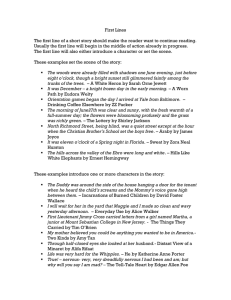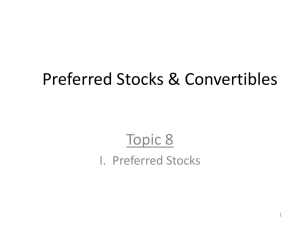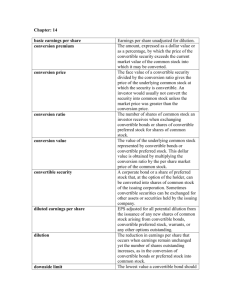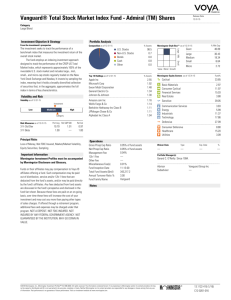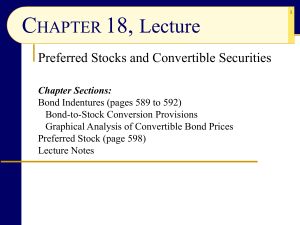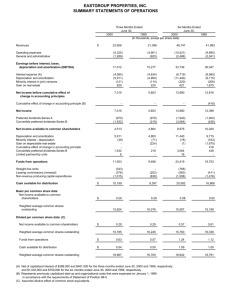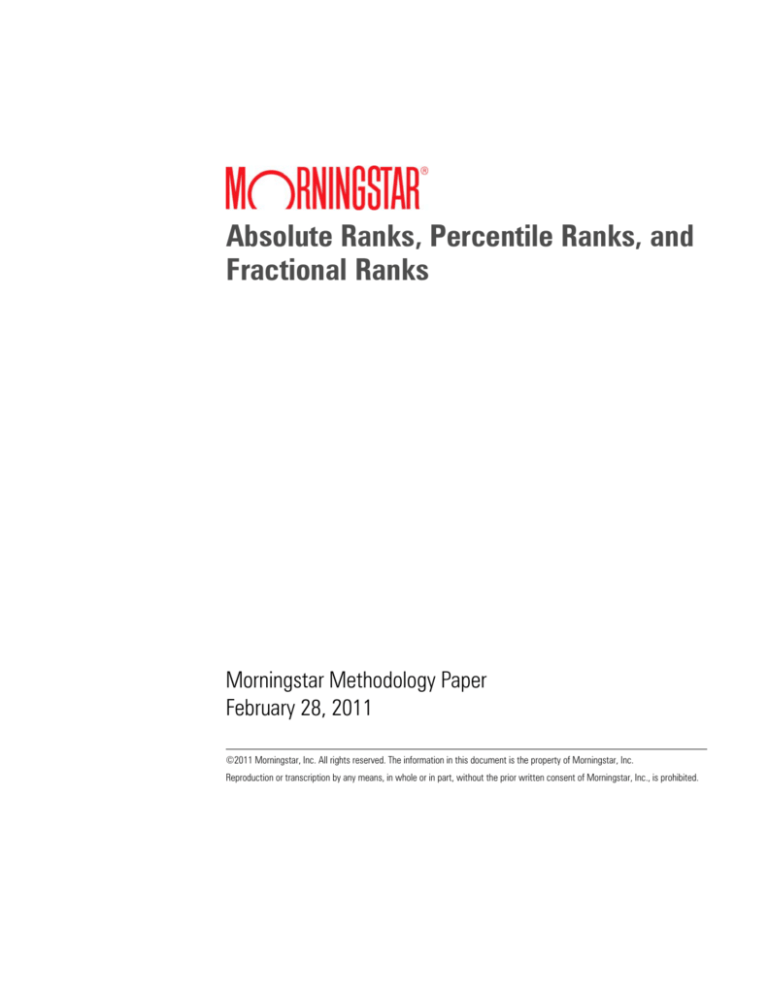
Absolute Ranks, Percentile Ranks, and
Fractional Ranks
Morningstar Methodology Paper
February 28, 2011
©2011 Morningstar, Inc. All rights reserved. The information in this document is the property of Morningstar, Inc.
Reproduction or transcription by any means, in whole or in part, without the prior written consent of Morningstar, Inc., is prohibited.
Methodology
Absolute Ranks
In order to assign percentile ranks to funds Morningstar first assigns an absolute rank.
The following procedure is used for assigning absolute ranks to funds:
1.
2.
3.
4.
Pull in the returns for the time period being ranked for all funds in a category.
Sort the returns in descending order.
Assigned a value of 1 to the highest return value.
When two share classes or two distinct portfolios share the same return assign the
same absolute rank to the share class or distinct portfolio.
Name
Tot Ret Annlzd 3 Yr
Absolute Rank
AXP Global Technology A
1.8386
36
AXP Global Technology Y
1.8386
36
5. For the next return that has a different value assign a rank equally to the absolute rank
of the previous fund plus the number of share classes or distinct portfolios that shared
the same return. In the example below two share classes shared the same return
1.8386.
Name
AXP Global Technology A
AXP Global Technology Y
Fidelity Select Software & Comp
Tot Ret Annlzd 3 Yr
Absolute Rank
1.8386
1.8386
1.7194
36
36
38
6. Continuing counting until the last absolute rank is assigned. The last absolute rank
value should be equal to the number of share classes in the category (n). This value
will be used in the formula for calculating the percentile rank.
Please note that Morningstar freezes absolute ranks and counts at the end of each month. If a
discrepancy is found in a fund return Morningstar may recalculate the fund’s percentile rank by
using breakpoints. By using breakpoints Morningstar does not have to recalculate the percentile
ranking for the entire peer group. Recalculation is not possible with absolute ranks therefore
instances may occur where absolute rank and percentile rank do not match. We expect these
instances to occur very seldom.
Morningstar Ranking Methodologies February 28 2011
© 2011 Morningstar, Inc. All rights reserved. The information in this document is the property of Morningstar, Inc. Reproduction or transcription by any means,
in whole or part, without the prior written consent of Morningstar, Inc., is prohibited.
2
Methodology
Percentile Ranks
Morningstar uses the following formula to determine the percentile rank of an item in a series.
It is commonly used for calculating an investment’s total return percentile rank against others in
its Morningstar Category. With this method, percentile ranks always range from 1 (best) to 100
(worst) with all intermediate values spread evenly over that range.
All observations are ranked in the desired order (usually descending). Percentile ranks are
assigned as follows:
PctRank =
i
FLOOR[99*(i-1)/(n-1)+1]
for i = 1
for i > 1
where:
n
=
Total number of observations
i
=
Absolute Rank of each observation
Floor
=
A function that rounds down to the next integer (e.g., 89.83 rounds down to 89)
Morningstar does not require a minimum number of items in order to percentile rank a set of
data. For example, if there are only three funds in a category for a certain time period, we will
percentile rank those three (1, 50, 100).
Percentile ranks can be mapped into deciles and quartiles in the following manner.
Range
Decile
Range
Quartile
0 < Percentile Rank <= 10
1
0 < Percentile Rank <= 25
1
10 < Percentile Rank <= 20
2
25 < Percentile Rank <= 50
2
20 < Percentile Rank <= 30
3
50 < Percentile Rank <= 75
3
30 < Percentile Rank <= 40
4
75 < Percentile Rank <= 100
4
40 < Percentile Rank <= 50
5
50 < Percentile Rank <= 60
6
60 < Percentile Rank <= 70
7
70 < Percentile Rank <= 80
8
80 < Percentile Rank <= 90
9
90 < Percentile Rank <= 100
10
Morningstar Ranking Methodologies February 28 2011
© 2011 Morningstar, Inc. All rights reserved. The information in this document is the property of Morningstar, Inc. Reproduction or transcription by any means,
in whole or part, without the prior written consent of Morningstar, Inc., is prohibited.
3
Methodology
Fractional Ranks
For some calculations, such as those related to the Morningstar Rating, Morningstar ranks
investments based on the number of distinct portfolios in a category, rather than giving equal
weight to each share class. This ensures that funds with multiple share classes do not have a
disproportionate weight compared to single-share funds.
When several funds are merely different share classes of the same underlying portfolio, each
share class is counted as a fraction of a fund. For example, if a fund has five share classes with
three years of returns available, each share class will get a weight of 0.20 for ranking three-year
returns. The first step in assigning ranks is to assign a fractional weight to each fund in the
category.
The fractional weight is assigned based on the number of share classes and whether each
share class has a return available. In this example, Convertible Income Growth is assigned a
fractional weight based on four share classes because the fifth share class, the Adv share
class, does not have a three year return.
Three Year
MRAR
-7.113
Fractional
Weight
0.2
Fund Name
Oldest Share Class
Convertible A
Yes
Convertible A Load Waived
No
-5.594
0.2
Convertible B
No
-7.158
0.2
Convertible C
No
-5.35
0.2
Convertible I
No
-5.35
0.2
Convertible Income Growth A
Yes
-12.749
0.25
No
-11.009
0.25
Convertible Income Growth A Load Waived
Convertible Income Growth Adv
No
Convertible Income Growth B
No
-12.522
0.25
Convertible Income Growth M
No
-12.522
0.25
Yes
-6.871
0.2
Convertible Securities Adv
Yes
-8.799
0.2
Convertible Securities A Load Waived
No
-7.145
0.2
Convertible Securities B
No
-8.7
0.2
Convertible Securities C
No
-7.822
0.2
Investment Grade Convertible A
Yes
-10.976
0.5
Investment Grade Convertible A Load Waived
No
-10.374
0.5
US Convertible I
Yes
-4.913
0.5
No
-4.804
0.5
Convertible Securities A
US Convertible II
Morningstar Ranking Methodologies February 28 2011
© 2011 Morningstar, Inc. All rights reserved. The information in this document is the property of Morningstar, Inc. Reproduction or transcription by any means,
in whole or part, without the prior written consent of Morningstar, Inc., is prohibited.
4
Methodology
There are five distinct portfolios in the example above: Convertible, Convertible Income Growth,
Convertible Securities, Investment Grade Convertible and US Convertible.
The next step is to sort all the funds in the category with the highest value first and the lowest
value last.
US Convertible II
No
Three Year
MRAR
-4.804
US Convertible I
Yes
-4.913
0.5
Convertible C
No
-5.35
0.2
Convertible I
No
-5.35
0.2
Convertible A Load Waived
No
-5.594
0.2
Convertible Securities A
Yes
-6.871
0.2
Convertible A
Yes
-7.113
0.2
Convertible Securities A Load Waived
No
-7.145
0.2
Convertible B
No
-7.158
0.2
Convertible Securities C
No
-7.822
0.2
Convertible Securities B
No
-8.7
0.2
Convertible Securities Adv
Yes
-8.799
0.2
Investment Grade Convertible A Load Waived
No
-10.374
0.5
Investment Grade Convertible A
Yes
-10.976
0.5
Convertible Income Growth A Load Waived
No
-11.009
0.25
Convertible Income Growth B
No
-12.522
0.25
Convertible Income Growth M
No
-12.522
0.25
Convertible Income Growth A
Yes
-12.749
0.25
Fund Name
Oldest Share Class
Fractional
Weight
0.5
You then calculate the cumulative weight for each fund. There are two steps to assigning the
cumulative weight. For step 1, the cumulative weight for the first fund is equal to the fractional
weight. The cumulative weight for the second fund is equal to the fractional weight of the
second fund plus the cumulative weight of the first fund and so forth.
Morningstar Ranking Methodologies February 28 2011
© 2011 Morningstar, Inc. All rights reserved. The information in this document is the property of Morningstar, Inc. Reproduction or transcription by any means,
in whole or part, without the prior written consent of Morningstar, Inc., is prohibited.
5
Methodology
Fractional
Weight
0.5
Cumulative
Weight
Step 1
0.5
US Convertible II
No
Three Year
MRAR
-4.804
US Convertible I
Yes
-4.913
0.5
1
Convertible C
No
-5.35
0.2
1.2
Convertible I
No
-5.35
0.2
1.4
Convertible A Load Waived
No
-5.594
0.2
1.6
Convertible Securities A
Yes
-6.871
0.2
1.8
Convertible A
Yes
-7.113
0.2
2
Convertible Securities A Load Waived
No
-7.145
0.2
2.2
Convertible B
No
-7.158
0.2
2.4
Convertible Securities C
No
-7.822
0.2
2.6
Convertible Securities B
No
-8.7
0.2
2.8
Convertible Securities Adv
Yes
-8.799
0.2
3
Investment Grade Convertible A Load Waived
No
-10.374
0.5
3.5
Investment Grade Convertible A
Yes
-10.976
0.5
4
Convertible Income Growth A Load Waived
No
-11.009
0.25
4.25
Convertible Income Growth B
No
-12.522
0.25
4.5
Convertible Income Growth M
No
-12.522
0.25
4.75
Convertible Income Growth A
Yes
-12.749
0.25
5
Fund Name
Oldest Share Class
In step 2 you need to compare the returns of the funds. In the example above if we went from
step 1 directly to assigning the percentile rank Convertible C and Convertible I would receive
different rankings even though they have the exact same return. To get the final cumulative
weight assign the first funds final cumulative weight equal to the cumulative weight step 1.
Next, if the return of the second fund is not equal to the return of the first fund then the final
cumulative weight is equal to the cumulative weight step 1. If the return of the second fund is
equal to the return of the first fund then the final cumulative weight is equal to the cumulative
weight step 1 of the first fund.
Morningstar Ranking Methodologies February 28 2011
© 2011 Morningstar, Inc. All rights reserved. The information in this document is the property of Morningstar, Inc. Reproduction or transcription by any means,
in whole or part, without the prior written consent of Morningstar, Inc., is prohibited.
6
Methodology
Final
Cumulative
Weight
0.5
US Convertible II
No
US Convertible I
Yes
-4.913
0.5
1
1
Convertible C
No
-5.35
0.2
1.2
1.2
Convertible I
No
-5.35
0.2
1.4
1.2
No
-5.594
0.2
1.6
1.6
Yes
-6.871
0.2
1.8
1.8
Convertible A
Yes
-7.113
0.2
2
2
Convertible Securities A Load Waived
No
-7.145
0.2
2.2
2.2
Convertible B
No
-7.158
0.2
2.4
2.4
Convertible Securities C
No
-7.822
0.2
2.6
2.6
Convertible Securities B
No
-8.7
0.2
2.8
2.8
Yes
-8.799
0.2
3
3
Investment Grade Convertible A Load Waived
No
-10.374
0.5
3.5
3.5
Investment Grade Convertible A
Yes
-10.976
0.5
4
4
Convertible Income Growth A Load Waived
No
-11.009
0.25
4.25
4.25
Convertible Income Growth B
No
-12.522
0.25
4.5
4.5
Convertible Income Growth M
No
-12.522
0.25
4.75
4.5
Yes
-12.749
0.25
5
5
Convertible A Load Waived
Convertible Securities A
Convertible Securities Adv
Convertible Income Growth A
Fractional
Weight
0.5
Cumulative
Weight
Step 1
0.5
Three Year
MRAR
-4.804
Fund Name
Oldest Share
Class
The last fund in the peer group receives a cumulative weight equal to the number of distinct
portfolios.
The final step is to assign a percentile rank to each fund. The ranks are simply the fund’s raw
rank in peer group (the cumulative weight of all funds up to and above it) divided by the total
number of distinct portfolios adjusted for the number of distinct observations in that group.
Morningstar Ranking Methodologies February 28 2011
© 2011 Morningstar, Inc. All rights reserved. The information in this document is the property of Morningstar, Inc. Reproduction or transcription by any means,
in whole or part, without the prior written consent of Morningstar, Inc., is prohibited.
7
Methodology
Fund Name
Three Year
MRAR
Final
Cumulative
Weight
Percentile
Rank
US Convertible II
-4.804
0.5
10.00%
US Convertible I
-4.913
1
20.00%
Convertible C
-5.35
1.2
24.00%
Convertible I
-5.35
1.2
24.00%
Convertible A Load Waived
-5.594
1.6
32.00%
Convertible Securities A
-6.871
1.8
36.00%
Convertible A
-7.113
2
40.00%
Convertible Securities A Load Waived
-7.145
2.2
44.00%
Convertible B
-7.158
2.4
48.00%
Convertible Securities C
-7.822
2.6
52.00%
Convertible Securities B
-8.7
2.8
56.00%
Convertible Securities Adv
-8.799
3
60.00%
Investment Grade Convertible A Load Waived
-10.374
3.5
70.00%
Investment Grade Convertible A
-10.976
4
80.00%
Convertible Income Growth A Load Waived
-11.009
4.25
85.00%
Convertible Income Growth B
-12.522
4.5
90.00%
Convertible Income Growth M
-12.522
4.5
90.00%
Convertible Income Growth A
-12.749
5
100.00%
This technique allows Morningstar to rank each fund share class individually, while ensuring
that any single portfolio with many versions does not crowd out others within a range.
Morningstar does not require a minimum number of items in order to percentile rank a set of
data.
Morningstar Ranking Methodologies February 28 2011
© 2011 Morningstar, Inc. All rights reserved. The information in this document is the property of Morningstar, Inc. Reproduction or transcription by any means,
in whole or part, without the prior written consent of Morningstar, Inc., is prohibited.
8
Methodology
Many funds are offering hedged share classes as part of their funds line up. These share
classes are for investors who want to hold across border assets but not have the foreign
exchange risk.
To accommodate these funds Morningstar will put the hedged currency share class in a
different category which reflects the funds investing style as well as the currency hedge
strategy.
For rating purposes a portfolio with a hedged share class and a non-hedged share class will be
represented as distinct portfolios in different categories for rating purposes.
For example:
Portfolio: Investment A
Name
Dollar Bond A1 USD
Dollar Bond A2 EUR
Category
USD Category
USD Category
Fractional Weight
0.5
0.5
Represents one distinct non-hedged portfolio in the USD Category. Note the base currency of a
class does not impact its classification absent hedging.
Name
Dollar Bond A1 EUR Hedged
Dollar Bond A2 EUR Hedged
Category
EUR Category
EUR Category
Fractional Weight
0.5
0.5
Represents one distinct hedged portfolio in the EUR Category. These classes are placed in a
different category as they are hedged to EUR.
Morningstar Ranking Methodologies February 28 2011
© 2011 Morningstar, Inc. All rights reserved. The information in this document is the property of Morningstar, Inc. Reproduction or transcription by any means,
in whole or part, without the prior written consent of Morningstar, Inc., is prohibited.
9

